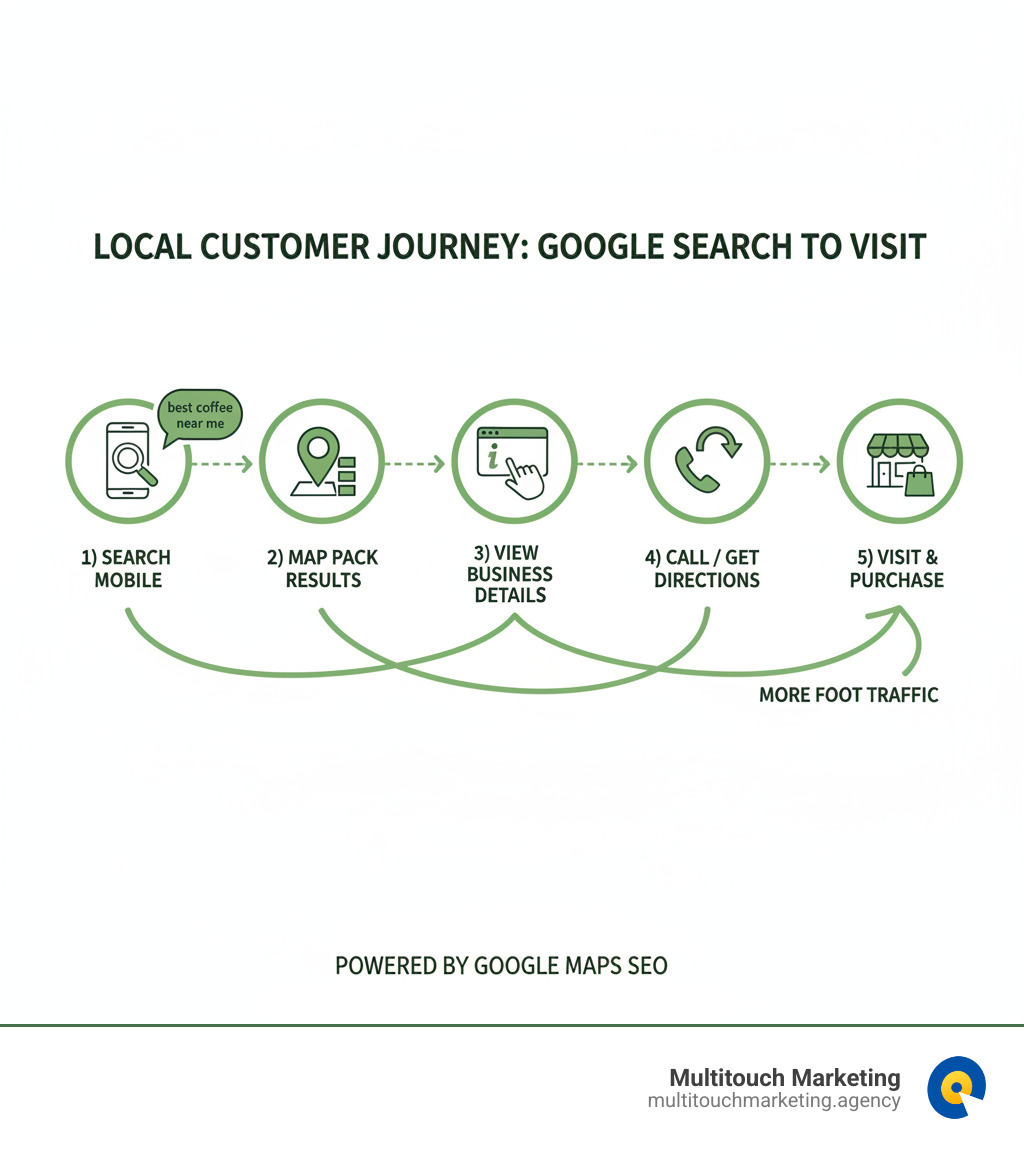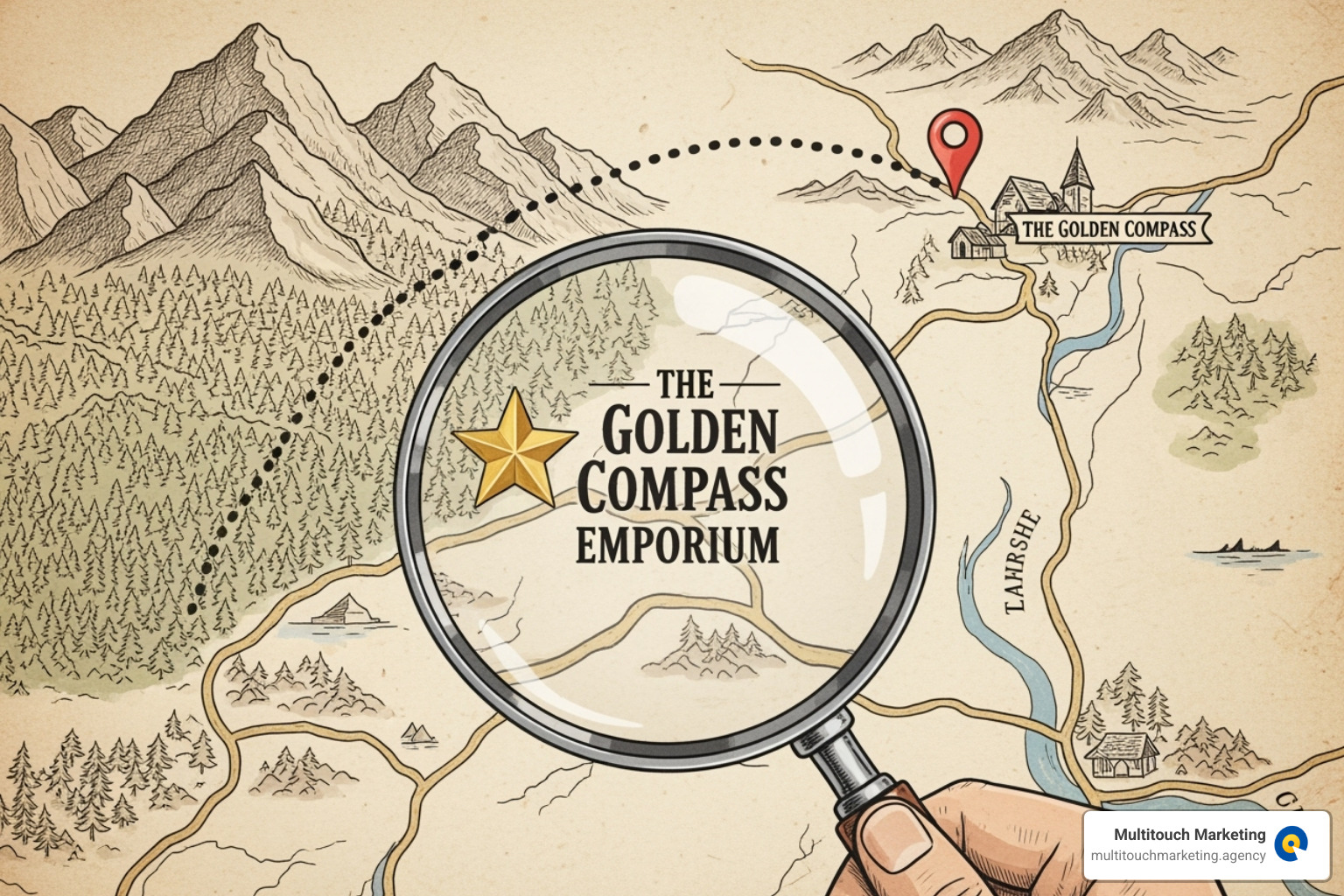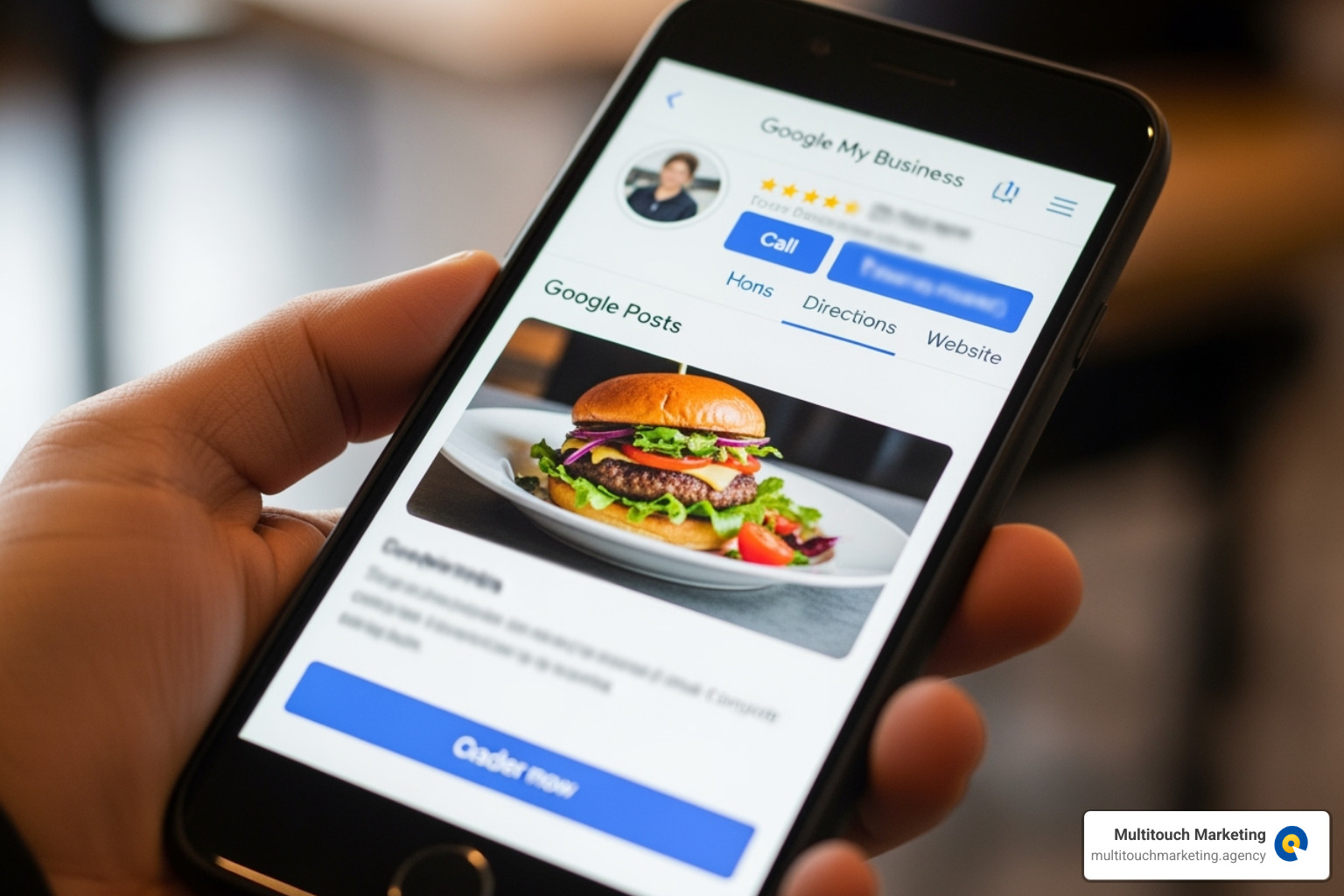What is Google Maps SEO and Why It’s a Game-Changer
Google Maps SEO is the process of optimizing your business listing to rank higher in Google’s local search results and on Google Maps. It involves several key actions:
Key Components:
- Claiming and optimizing your Google Business Profile (GBP)
- Maintaining consistent NAP (Name, Address, Phone) information
- Encouraging and responding to customer reviews
- Using local keywords in your business description and website
- Adding high-quality photos and videos
- Building local citations and backlinks
Primary Benefits:
- Appearing in the coveted Google “Map Pack” (the top 3 local results)
- Driving more foot traffic
- Increasing calls and website visits
- Building local trust and credibility
When someone searches for “best coffee shop near me,” they’re ready to act. With 46% of all Google searches seeking local information and over 50% of those clicks going to the Map Pack, ranking in Google Maps is essential. The stakes are high: 28% of local searches lead to conversions, and 76% of mobile users who perform a local search visit a physical location within 24 hours. If your competitors are optimized for Google Maps and you aren’t, you’re losing customers daily. Experience shows that Google Maps SEO often delivers faster results than traditional SEO, driving highly qualified traffic that converts.
The Foundation: Claiming and Optimizing Your Google Business Profile (GBP)
Your Google Business Profile (GBP) is the cornerstone of your Google Maps SEO strategy. Without a well-maintained profile, you’re invisible to the 86% of consumers using Google Maps to find businesses. The first step is to claim and verify your profile.
Start by visiting the Google Business Profile page and clicking “Manage now.” Google uses methods like postcard, phone, or email to verify ownership, which gives you full control over your listing. For more guidance, see our Google My Business SEO Tips.
Completing Your Profile for Maximum Impact
An incomplete GBP is a missed opportunity. Fill out every section to tell Google what your business does, where it is, and why customers should choose you. Focus on these essential fields:
- Business Name: Use your exact, real-world business name without extra keywords.
- Primary & Secondary Categories: Choose the most specific primary category and add secondary categories for all other services.
- Address: Ensure it’s precise and matches your physical location.
- Service Areas: For businesses that travel to customers (SABs), define your service areas instead of showing a physical address.
- Hours: Keep hours updated, including holidays. 54% of local searchers check hours, so accuracy is crucial.
- Phone Number: Use a local number to reinforce your local presence.
- Website: Link to your official business website.
- Products & Services: Detail all your offerings to help Google match you with customer queries.
- Business Description: Write a compelling, keyword-rich description highlighting your unique selling points (USPs).
- Attributes: Select all relevant attributes (e.g., “wheelchair accessible,” “free Wi-Fi”) to match specific user searches.
The Critical Role of NAP Consistency
Conflicting business information online confuses customers and Google. NAP (Name, Address, Phone Number) consistency is critical. Your core business details must be identical across your GBP, website, social media, and all local directories (citations). Google rewards consistent NAP with trust and higher rankings, while inconsistencies can harm your visibility. Regularly audit your online presence to correct errors. Learn more in our article on Google Maps Citations for Local Business SEO.
Optimizing Photos and Videos for Engagement
Visuals are crucial. Businesses with photos receive 42% more direction requests and 35% more website clicks. High-quality images and videos make your profile engaging and help customers visualize your business.
Upload a variety of visuals:
- Storefront Photos: Help customers find you.
- Interior Shots: Show off your ambiance.
- Team Photos: Build trust and personality.
- Product/Service Images: Showcase your work or best-selling items.
- Geo-tagging: Geo-tag photos before uploading to add local relevance.
- Video Tours: Short videos (under 30 seconds) offer a dynamic preview.
Regularly add new visuals to keep your profile fresh. Google and customers reward activity.
Understanding Google’s Local Ranking Factors
So, your GBP is optimized. How does Google decide who ranks at the top? The local algorithm isn’t a mystery; it’s based on three pillars: Relevance, Distance, and Prominence. As Google explains, these factors help answer a searcher’s key questions: Is this business what I’m looking for? (Relevance), How close is it? (Distance), and Can I trust it? (Prominence). While you can’t pay for better organic local rankings, you can optimize for each of these elements.
Relevance: Matching Searcher Intent
Relevance is about matching what a user searches for. To improve relevance:
- Use Keywords Naturally: Include relevant search terms in your business description and services, but avoid awkward keyword stuffing.
- Choose Accurate Categories: Select the most specific primary and secondary categories to describe the full scope of your business.
- Complete Your Profile: A thoroughly filled-out profile with detailed services, products, and attributes helps Google understand what you do and match you to more queries.
- Be Specific with Services: Instead of “home repairs,” list “kitchen cabinet installation” or “deck refinishing.” Detail helps Google make better connections.
Distance: Proximity to the Searcher
Distance refers to the searcher’s proximity to your business. While you can’t change your location, you can ensure Google understands it.
- Accurate Address: Your GBP address must be precise for Google to show you to nearby customers.
- Local Intent: Google understands local intent even without “near me.” A search for “Italian restaurant” in Raleigh will yield Raleigh-based results.
- Service Area Businesses (SABs): If you travel to customers, accurately defining your service areas in GBP is essential to tell Google your geographical reach.
Prominence: Building Your Local Authority
Prominence is Google’s measure of your business’s authority and trustworthiness. It’s your local reputation.
- Online Reviews: The quantity, quality, and recency of your Google reviews are powerful signals. A steady stream of positive reviews shows Google you’re active and popular.
- Local Backlinks: Links from local sources (chamber of commerce, local blogs) act as votes of confidence, signaling your legitimacy.
- Citations: Consistent NAP information across online directories (Yelp, Yellow Pages) reinforces Google’s trust in your business data.
- Brand Mentions: Even without a link, mentions of your business on social media or forums contribute to your prominence.
- Website Authority: A professional, fast, and content-rich website signals to Google that you’re an established business.
Advanced Strategies for Dominating Google Maps SEO
Once your foundation is solid, it’s time for advanced tactics. The businesses that dominate Google Maps SEO actively manage their presence. Consistent care yields the best results. For broader insights, check out our SEO Optimization Tips.
Mastering Reviews and the Q&A Feature for your Google Maps SEO
Reviews are critical for Google Maps SEO, influencing both rankings and customer decisions.
- Encourage Reviews: Systematically ask for reviews after a positive interaction. Make it easy by sending a direct link via text or email.
- Respond to All Reviews: Thank positive reviewers personally. Address negative reviews professionally and empathetically, offering solutions to show you’re committed to service.
- Maintain Review Velocity: A steady stream of recent reviews is more valuable than a large number of old ones, signaling that your business is currently active.
- Manage the Q&A Section: Proactively add common questions and provide keyword-rich answers (e.g., “Do you offer emergency services?”). This gives you control over the information and helps customers.
Leveraging Google Posts for Timely Updates
Google Posts are a free, powerful feature many businesses ignore. Use them to share timely updates directly in your search and Maps listing.
Create posts for:
- Offers: Drive immediate action with special deals.
- Events: Announce workshops, sales, or community involvement.
- Updates: Share news about new products, services, or holiday hours.
Always include a clear call-to-action (CTA) like “Learn More” or “Call Now.” Posts expire, so post consistently to signal to Google that your business is active. Learn more about how Google Posts work.
Strengthening Your Website’s Local Signals
Your website and GBP work as a team. A strong website reinforces your local signals.
- Mobile Optimization & Page Speed: Your site must be fast and responsive on mobile, where most local searches happen. Slow sites lose customers and rankings.
- Local Keywords: Weave local keywords naturally into your content. Write about serving your community, like “providing plumbing services to the Triangle area.”
- Location Pages: For multiple locations, create a unique page for each with local NAP, an embedded map, and community-specific content.
- Embed a Google Map: Add a Google Map to your contact page to reinforce your location.
- LocalBusiness Schema: Implement LocalBusiness Schema markup. This structured data helps search engines understand your business details.
Tracking Performance and Paid Amplification
After optimizing your Google Maps SEO, you must track performance to see what’s working. Google provides free tools to measure your progress, and paid options can accelerate your results.
Measuring Your Google Maps SEO Success
Your GBP Insights dashboard shows how customers find and interact with your listing. A key metric is “findy” vs. “direct” searches. Findy searches (e.g., “plumber near me”) are how most new customers find you, as 84% of interactions with GBP listings come from findy searches. This means people are looking for your service, not your name.
Track these key actions:
- Website Clicks: Shows interest in learning more.
- Direction Requests: A strong indicator of foot traffic.
- Phone Calls: High-intent leads ready to book or buy.
- Photo Views: Measures the engagement of your visual content.
Use Google Analytics and Search Console for a broader view of how local search drives website traffic. For more on this, see our guide on Generating Organic Visits for Google Business Profile.
Boosting Visibility with Google Local Services Ads
For faster results, consider Google Local Services Ads (LSAs). They appear at the very top of search results, above the Map Pack.
Key benefits include:
- Pay-Per-Lead Model: You only pay for qualified leads (calls or messages), not just clicks.
- Google Guaranteed Badge: This badge builds immense trust, as Google backs your service. It can be the deciding factor for customers.
LSAs are ideal for service-based businesses (plumbers, electricians, etc.) and allow for precise geographic and service targeting. Combining organic Google Maps SEO for long-term authority with LSAs for immediate leads creates a powerful local marketing strategy. Learn more about Google Local Services Ads to see if they fit your business.
Frequently Asked Questions about Google Maps SEO
Here are answers to common questions about Google Maps SEO.
What’s the difference between Google Maps SEO and traditional SEO?
Google Maps SEO is your local strategy, while traditional SEO is your global one. They have different goals and methods.
- Google Maps SEO: Focuses on local queries (“plumber near me”). Key signals are your GBP, NAP consistency, reviews, and proximity. The goal is to drive foot traffic, calls, and appear in the local Map Pack.
- Traditional SEO: Focuses on broader search queries. Key signals are website content, backlinks, and technical performance. The goal is to increase website traffic and online conversions.
Simply put, Google Maps SEO gets customers to your physical location, while traditional SEO gets them to your website. Local businesses need both, but Maps SEO often yields faster, more immediate results.
How long does it take to see results from Google Maps optimization?
The timeline for results varies based on competition and your starting point.
- Short-Term Wins (Weeks): You can see quick improvements by claiming and optimizing your GBP, fixing NAP inconsistencies, and getting a few new reviews.
- Long-Term Success (Months): Significant ranking improvements, especially in competitive markets, take time. This requires consistent effort in building reviews, posting updates, and earning local backlinks.
Your market’s competitiveness is a major factor. A business in a small town may rank faster than one in a dense urban area like downtown Raleigh. Google Maps SEO is an ongoing commitment, not a one-time fix.
Can I rank in a city where I don’t have a physical address?
Yes, but you must follow Google’s strict rules.
- Service Area Businesses (SABs): Businesses like plumbers or electricians that travel to customers can rank in their service areas. You set up your GBP to hide your physical address and define the areas you serve.
- Virtual Offices & Co-working Spaces: These are only permissible if they are staffed by your employees during your stated business hours. A simple mailbox rental violates Google’s guidelines and can lead to suspension.
The main challenge is that proximity is a key ranking factor. A business with a physical address in a city has an inherent advantage. To compete, SABs must excel in all other areas: GBP optimization, reviews, citations, and website authority.
Conclusion: Put Your Business on the Map
Google Maps SEO is your direct line to local customers ready to buy. By mastering the strategies we’ve covered—from optimizing your Google Business Profile to advanced tactics—you can move from being invisible online to a local market leader.
Local optimization often delivers faster results than traditional SEO. Nailing the fundamentals like completing your GBP, ensuring NAP consistency, managing reviews, and using Google Posts gives Google the signals it needs to recommend you.
Google Maps SEO is an ongoing effort. Consistent engagement is what separates the top-ranking businesses from the rest. Your competitors are already active, capturing customers that could be yours. With the strategies in this guide, you have a clear roadmap to compete and win.
At Multitouch Marketing, we know that SEO Pushes Business Growth. We create custom strategies for businesses in the Triangle and beyond, rejecting one-size-fits-all solutions.
Ready to put your business on the map and turn local searches into real growth? Get expert help with your Local SEO in Raleigh and let’s make sure customers find you first.



